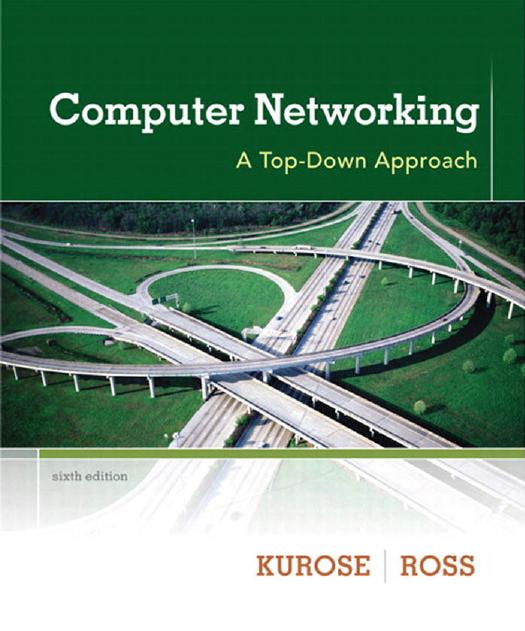Computer Networking: A Top-Down Approach by James F. Kurose & Keith W. Ross

Author:James F. Kurose & Keith W. Ross
Language: eng
Format: azw3, pdf
Publisher: Pearson Education
Published: 2012-06-01T04:00:00+00:00
434
CHAPTER 5 • THE LINK LAYER: LINKS, ACCESS NETWORKS, AND LANS
access networks. Since many hosts are connected to the same broadcast communica-
tion channel, a so-called medium access protocol is needed to coordinate frame
transmission. In some cases, a central controller may be used to coordinate transmis-
sions; in other cases, the hosts themselves coordinate transmissions. The second type
of link-layer channel is the point-to-point communication link, such as that often
found between two routers connected by a long-distance link, or between a user’s
office computer and the nearby Ethernet switch to which it is connected. Coordinating
access to a point-to-point link is simpler; the reference material on this book’s web site has a detailed discussion of the Point-to-Point Protocol (PPP), which is used in settings ranging from dial-up service over a telephone line to high-speed point-to-point
frame transport over fiber-optic links.
We’ll explore several important link-layer concepts and technologies in this chap-
ter. We’ll dive deeper into error detection and correction, a topic we touched on briefly in Chapter 3. We’ll consider multiple access networks and switched LANs, including
Ethernet—by far the most prevalent wired LAN technology. We’ll also look at virtual
LANs, and data center networks. Although WiFi, and more generally wireless LANs,
are link-layer topics, we’ll postpone our study of these important topics until Chapter 6.
5.1 Introduction to the Link Layer
Let’s begin with some important terminology. We’ll find it convenient in this chapter to refer to any device that runs a link-layer (i.e., layer 2) protocol as a node. Nodes include hosts, routers, switches, and WiFi access points (discussed in Chapter 6). We will
also refer to the communication channels that connect adjacent nodes along the com-
munication path as links. In order for a datagram to be transferred from source host to destination host, it must be moved over each of the individual links in the end-to-end path. As an example, in the company network shown at the bottom of Figure 5.1, consider sending a datagram from one of the wireless hosts to one of the servers. This datagram will actually pass through six links: a WiFi link between sending host and WiFi
access point, an Ethernet link between the access point and a link-layer switch; a link between the link-layer switch and the router, a link between the two routers; an
Ethernet link between the router and a link-layer switch; and finally an Ethernet link
between the switch and the server. Over a given link, a transmitting node encapsulates
the datagram in a link-layer frame and transmits the frame into the link.
In order to gain further insight into the link layer and how it relates to the network
layer, let’s consider a transportation analogy. Consider a travel agent who is planning a trip for a tourist traveling from Princeton, New Jersey, to Lausanne, Switzerland. The
travel agent decides that it is most convenient for the tourist to take a limousine from Princeton to JFK airport, then a plane from JFK airport to Geneva’s airport, and finally a train from Geneva’s airport to Lausanne’s train station. Once the travel agent makes
the three reservations, it is the responsibility
Download
Computer Networking: A Top-Down Approach by James F. Kurose & Keith W. Ross.pdf
This site does not store any files on its server. We only index and link to content provided by other sites. Please contact the content providers to delete copyright contents if any and email us, we'll remove relevant links or contents immediately.
Sass and Compass in Action by Wynn Netherland Nathan Weizenbaum Chris Eppstein Brandon Mathis(7968)
Grails in Action by Glen Smith Peter Ledbrook(7940)
Configuring Windows Server Hybrid Advanced Services Exam Ref AZ-801 by Chris Gill(7340)
Azure Containers Explained by Wesley Haakman & Richard Hooper(7325)
Running Windows Containers on AWS by Marcio Morales(6873)
Kotlin in Action by Dmitry Jemerov(5367)
Microsoft 365 Identity and Services Exam Guide MS-100 by Aaron Guilmette(5340)
Microsoft Cybersecurity Architect Exam Ref SC-100 by Dwayne Natwick(5105)
Combating Crime on the Dark Web by Nearchos Nearchou(4916)
The Ruby Workshop by Akshat Paul Peter Philips Dániel Szabó and Cheyne Wallace(4609)
Management Strategies for the Cloud Revolution: How Cloud Computing Is Transforming Business and Why You Can't Afford to Be Left Behind by Charles Babcock(4510)
The Age of Surveillance Capitalism by Shoshana Zuboff(4192)
Python for Security and Networking - Third Edition by José Manuel Ortega(4177)
Learn Wireshark by Lisa Bock(4021)
The Ultimate Docker Container Book by Schenker Gabriel N.;(3834)
Learn Windows PowerShell in a Month of Lunches by Don Jones(3587)
DevSecOps in Practice with VMware Tanzu by Parth Pandit & Robert Hardt(3506)
Windows Ransomware Detection and Protection by Marius Sandbu(3498)
Blockchain Basics by Daniel Drescher(3474)
